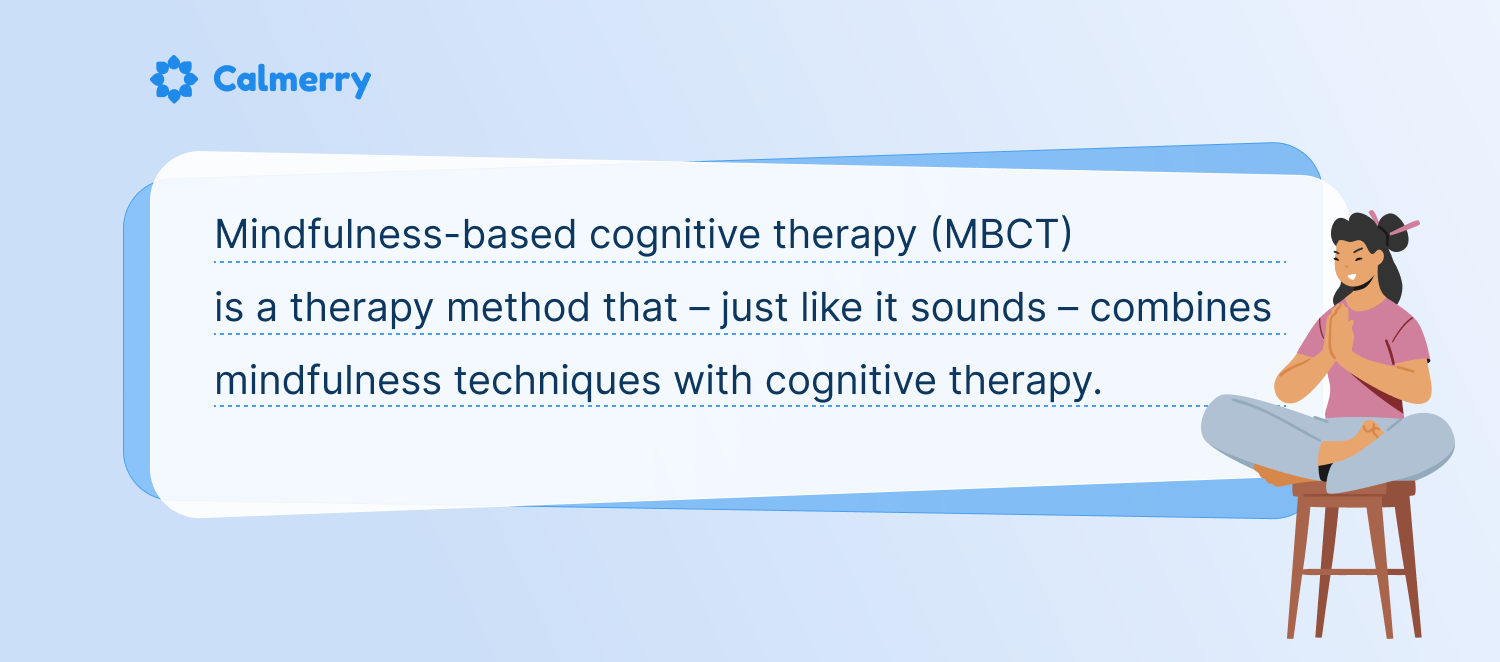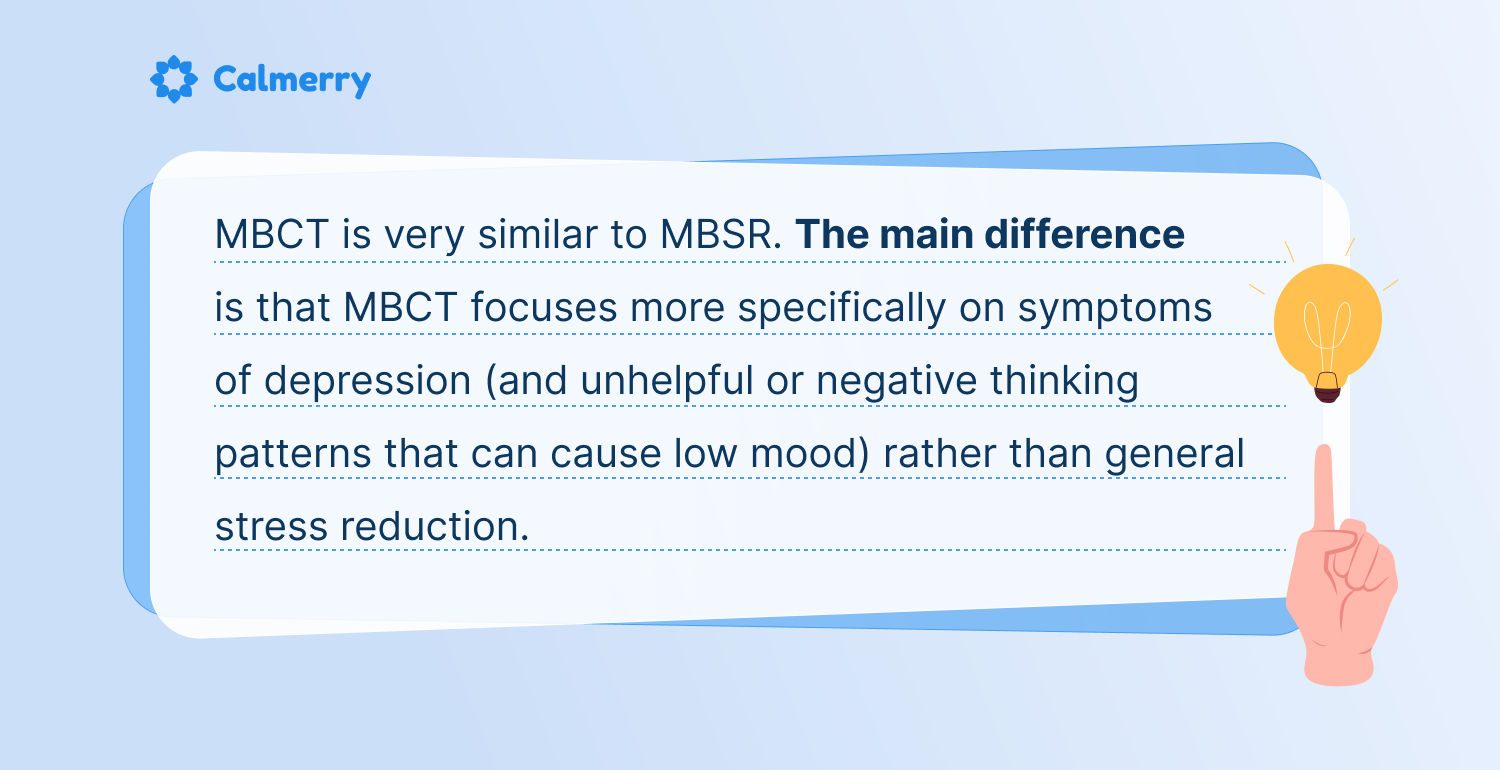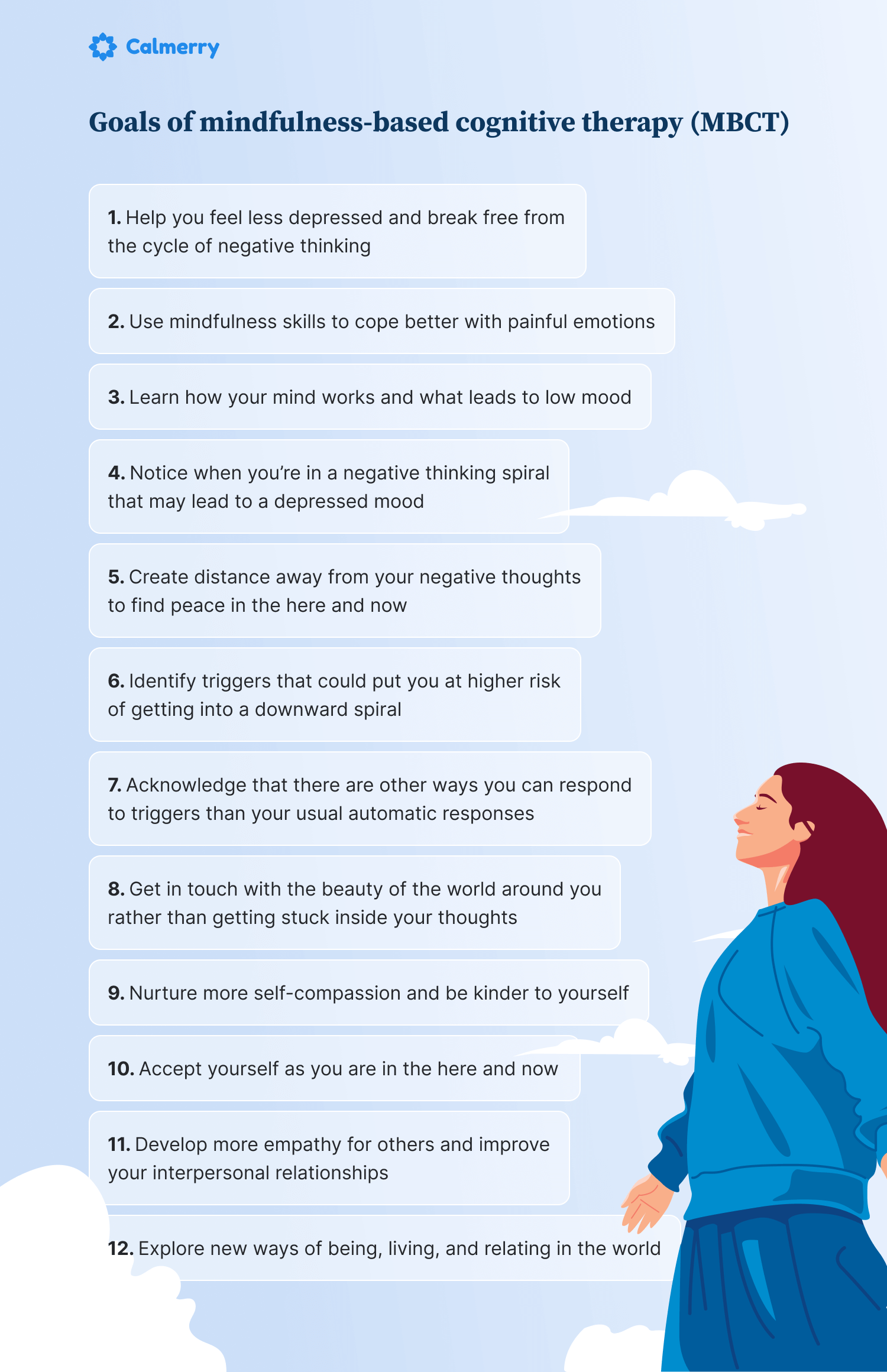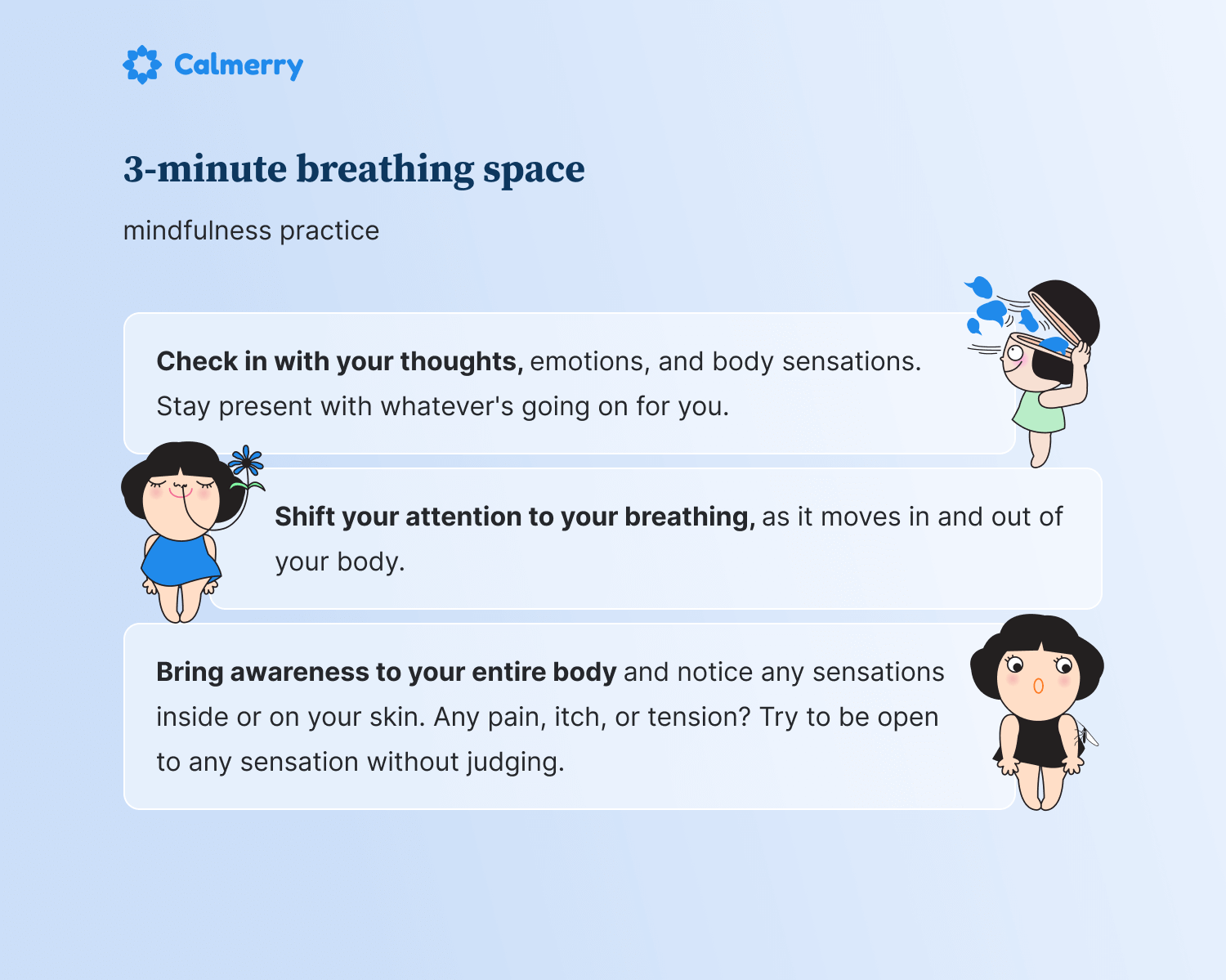Mindfulness-Based Cognitive Therapy (MBCT): How It Works and When It’s Used

In this article
Breathe in and out. Keep your attention on your breath. Stretch your arms high above your head, and relax your shoulders.
If you’ve ever been to a yoga or meditation class, then these statements probably sound very familiar to you.
But did you know that yoga, meditation, and other mindfulness techniques are not purely for relaxation? Research shows that these techniques can be successfully used to treat depression and other mental health disorders.
Mindfulness-based cognitive therapy is a therapy method that combines the powerful benefits of CBT and mindfulness. It’s been proven effective for depression, anxiety, and more.
Could this unique treatment method help you? Read on to learn more.
What is mindfulness-based cognitive therapy (MBCT)?
Mindfulness-based cognitive therapy (MBCT) is a therapy method that – just like it sounds – combines mindfulness techniques with cognitive therapy.
MBCT was originally formulated to treat depression. It’s usually delivered as a group-based 8-week course, with an additional full-day retreat.

MBCT was developed in 2002, when therapists Zindel Segal, Mark Williams, and John Teasdale sought to make cognitive-behavioral therapy (CBT) even more powerful in the treatment of depression by delivering it together with the practice of mindfulness.
To truly understand what MBCT is, it’s helpful to understand its two components – mindfulness and cognitive therapy.
Mindfulness
Mindfulness is an ancient practice originally borrowed from Eastern spiritual traditions. In short, mindfulness is the practice of maintaining non-judgmental awareness of each present moment.
The most common way to practice mindfulness is through sitting or walking meditation, but any task can be turned into a mindfulness exercise. It’s simply about staying present without allowing thoughts about the past and future to distract us.
Buddhists have been teaching and practicing mindfulness for millennia, and the practice is now used as a secular intervention in medicine and mental health. Jon Kabat-Zinn was one of the first medical professionals to bring mindfulness to the West.
Cognitive therapy
Cognitive therapy is a common therapy method that helps people understand the connection between their thoughts and feelings. The core principle of cognitive therapy is that unhelpful thinking patterns cause painful emotions.
For example, someone may have the thought: “I’m unlovable. No one wants to spend time with me.” after not being invited to an event. This thought understandably makes them feel lonely, worthless, and depressed.
But if they replaced this thought with: “It hurt my feelings that I didn’t get invited, but I have many friends who love me and who do invite me out,” then they are less likely to feel down.
Cognitive therapy is one essential part of cognitive-behavioral therapy (CBT), which combines cognitive therapy with behavior therapy.
MBCT vs. MBSR
Kabat-Zinn created mindfulness-based stress reduction, or MBSR, in the 1970s. Since then, it’s been successfully used for a wide range of health problems, including:
- Depression
- Anxiety
- Stress
- Chronic pain
- Hypertension
- Immune disorders, and more.
MBCT is very similar to MBSR since the creators of MBCT based their therapy model on Kabat-Zinn’s original method.
The main difference is that MBCT focuses more specifically on symptoms of depression (and unhelpful or negative thinking patterns that can cause low mood) rather than general stress reduction.

MBCT vs. CBT
MBCT is a type of CBT – but there are many other types.
Cognitive-behavioral therapy (CBT) is a very common and research-proven treatment method effective for many problems, including depression, anxiety, obsessive-compulsive disorder (OCD), post-traumatic stress disorder, chronic pain, insomnia, and more.
Cognitive-behavioral therapy is an umbrella with many other, more specific therapy methods falling under it. Any type of therapy that works by helping people identify and change unhelpful thinking patterns or behaviors is considered CBT.
What are the goals of mindfulness-based cognitive therapy?
The main goal of MBCT is to help people feel less depressed. MBCT therapists meet this goal by teaching people to identify negative thinking patterns that lead to low mood.
In MBCT, you can learn to use both CBT and mindfulness techniques to become more aware of your thoughts and feelings. The goal is to help you break free from the cycle of negative thinking and use mindfulness skills to cope better with painful emotions.
Other goals of MBCT include helping you to:
- Learn how your mind works and what leads to low mood
- Notice when you’re in a negative thinking spiral that may lead to a depressed mood
- Create distance away from your negative thoughts to find peace in the here and now
- Identify triggers that could put you at higher risk of getting into a downward spiral
- Acknowledge that there are other ways you can respond to triggers than your usual automatic responses
- Get in touch with the beauty of the world around you rather than getting stuck inside your thoughts
- Nurture more self-compassion and be kinder to yourself
- Accept yourself as you are in the here and now
- Develop more empathy for others and improve your interpersonal relationships
- Explore new ways of being, living, and relating in the world

What can MBCT help with?
MBCT was originally created to help people struggling with depression and low mood. But it can successfully be applied to any problem that is caused or worsened by negative thinking spirals, including:
- Major depressive disorder
- Treatment-resistant depression (chronic depression)
- Anxiety (Generalized anxiety disorder)
- Social anxiety
- Bipolar disorder
- Borderline personality disorder
- Post-traumatic stress disorder (PTSD) and other trauma responses
- Traumatic brain injury (and associated depression)
- Obsessive-compulsive disorder (OCD)
- Migraine
- Substance use disorder
- Chronic pain
- Vascular disease
MBCT techniques and exercises
MBCT therapists use different techniques and teach several exercises when delivering MBCT.
Since MBCT is a structured 8-week program, each 2-hour session is typically focused on a specific theme with 2 or 3 relevant exercises. Clients are also given homework after each session to practice these skills at home.
Some of the techniques and exercises that are included in the MBCT program include:
Sitting meditation
Sitting meditation is a skill reviewed throughout the MBCT program, one of the most common and traditional ways to practice mindfulness.
During sitting meditation, you’re guided to sit quietly in a comfortable position. You will learn how to rest your awareness on your breath as it moves in and out of your body. By focusing on your breath, you’re able to anchor yourself to the present moment rather than get lost in your thoughts.
More advanced sitting meditation exercises might include meditating to be present with your feelings, with the world around you, or with your body sensations.
Body scan
The body scan is another core relaxation technique in MBCT. In this mindfulness exercise, you “scan” through every body part and notice how you’re feeling.
For example, you may start with your toes and feet. Notice any tension that’s present in your toes and feet. Some practitioners may teach you to tense and relax each body part as you move through it.
Then, move up to your shins, your knees, your thighs, abdomen, and so on. The idea is to notice and release any tension within your body to feel more relaxed.
Three-minute breathing space
The three-minute breathing space is a technique that’s unique to MBCT.
In this exercise, you will be asked to check in with yourself – your thoughts, emotions, and body sensations – and stay present with whatever is going on for you.
The second step is to shift your attention to your breathing, just like you learned how to do during sitting meditation.
Next, bring your awareness to your entire body and notice any sensations you’re feeling inside of your body or on your skin. Do you feel an itch somewhere? Any pain or tension? Try to be open and receptive to any sensation without judging.

Yoga
Floor or standing yoga, also sometimes called mindful movement, is also an important exercise in MBCT.
Yoga is an ancient practice that originated in India. Although it’s now mostly used in the West for the purposes of fitness, it was originally intended to help people with their meditative and spiritual practices.
Your MBCT therapist may guide you to try different yoga poses that facilitate relaxation. The idea is to become more connected and present with your body.
You will also practice these yoga poses as homework between sessions.
What is the effectiveness of MBCT?
Research studies have shown that MBCT is effective for a variety of different health conditions, but especially for depression.
Multiple randomized controlled trials – the highest quality of research – have found MBCT to be effective for preventing depression relapse, especially for people with severe depression.
Relapse is when someone feels better after treatment, only for depression symptoms to return some time later. Relapse is very common in depression – around 80% of people who’ve had two or more depressive episodes will relapse at least once.
When MBCT is used, especially together with another depression treatment, people are less likely to relapse.
One older study from Cambridge found that only 37% of people who received MBCT relapsed after 60 weeks, compared with 66% of people receiving treatment as usual.
Limitations of MBCT
Overall, MBCT is a safe and effective intervention that can help many people. It’s also been found to be cost-effective compared to other depression treatment methods because it’s short-term and usually delivered in a group.
It’s not likely that you’ll experience any dangerous effects from participating in MBCT, but some people may experience physical or mental strain from some of the exercises.
It’s also important to keep in mind that MBCT – and mindfulness in general – isn’t a panacea and shouldn’t be used for every problem. Although receiving MBCT won’t hurt, it may not always be enough for what you’re going through.
For example, if you’ve experienced significant trauma, you will likely need to see a trauma specialist to recover from the effects of these experiences.
MBCT may be helpful in teaching you skills to cope, but on its own, it probably won’t be enough to help you recover from severe trauma.
What to look for in an MBCT therapist
Because the official MBCT program is delivered in a structured group setting, it may be helpful to start by looking for groups local to your area or online. You may find groups specific to whatever you’re facing, including depression and anxiety.
Many therapists also borrow strategies and teachings from MBCT without delivering it in the structured 8-week format. Although the research studies have measured the effectiveness of the MBCT group, you may also benefit from learning these mindfulness skills outside of the group setting.
Look for a therapist who:
- Is experienced and trained in cognitive-behavioral therapy
- Is a seasoned mindfulness practitioner and/or facilitator
- Has delivered or observed an MBSR or MBCT group
- Has experience and knowledge in the treatment of the mental health problem you’re facing
- Makes you feel safe and comfortable
- Is licensed to deliver mental health therapy
Learn mindfulness skills with Calmerry
At Calmerry, we have licensed therapists who specialize in a wide range of therapy methods, including mindfulness-based cognitive therapy (and other mindfulness-based therapies).
Although we don’t currently offer MBCT in the group format, our qualified online therapists can adapt the MBCT program to be delivered in individual therapy.
Get in touch with us so that we can match you with a therapist who meets your specific mental health needs.
online therapy
live video session




